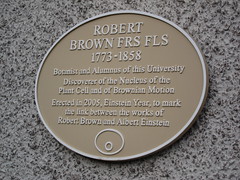Robert Brown
Commemorated on 2 plaques
Sir Joseph Banks 1743-1820, President of the Royal Society, Robert Brown 1773-1858 and, David Don 1800-1841 botanists, lived in a house on this site, The Linnean Society met here 1821-1857
32 Soho Square, Westminster, W1, London, United Kingdom where they lived
Robert Brown FRS FLS 1773-1858 Botanist and Alumnus of this University Discoverer of the Nucleus of the Plant Cell and of Brownian Motion Erected in 2005, Einstein Year, to mark the link between the works of Robert Brown and Albert Einstein
Cruikshank Building, Chanonry, Aberdeen, United Kingdom where they was

.jpg?width=250)

